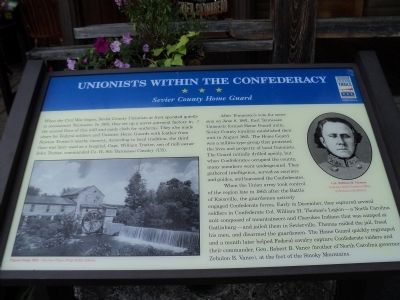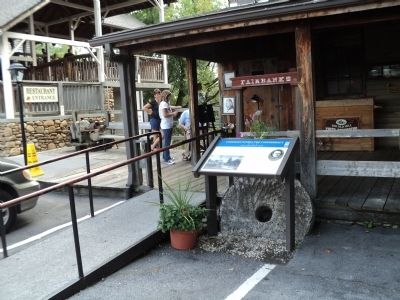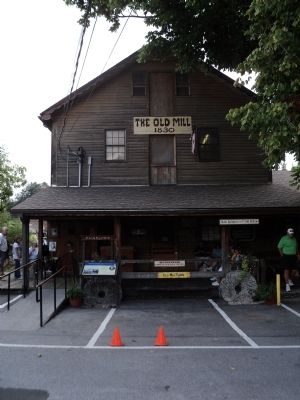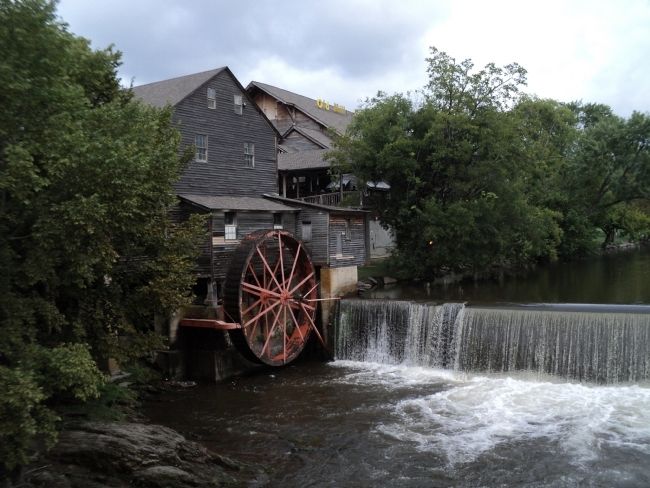Pigeon Forge in Sevier County, Tennessee — The American South (East South Central)
Unionists Within the Confederacy
Sevier County Home Guard
When the Civil War began, Sevier County Unionists at first operated quietly in secessionist Tennessee. In 1861, they set up a secret garment factory in the second floor of this mill and made cloth for uniforms. They also made shoes for Federal soldiers and Unionist Home Guards with leather from Newton Trotter’s nearby tannery. According to local tradition, the third floor was later used as a hospital. Captain William Trotter, son of mill owner John Trotter, commanded Company H, 9th Tennessee Cavalry (US).
After Tennessee’s vote for secession on June 8, 1861, East Tennessee Unionists formed Home Guard units. Sevier County loyalists established their unit in August 1861. The Home Guard was a militia-type group that protected the lives and property of local Unionists. The Guard initially drilled openly, but when Confederates occupied the county, many members went underground. They gathered intelligence, served as couriers and guides, and harassed the Confederates.
When the Union army took control of the region late in 1863 after the Battle of Knoxville, the guardsmen actively engaged Confederate forces. Early in December, they captured several soldiers in Confederate Colonel William H. Thomas’s Legion – a North Carolina unit composed of mountaineers and Cherokee Indians that was camped at Gatlinburg – and jailed them in Sevierville. Thomas raided the jail, freed his men, and disarmed the guardsmen. The Home Guard quickly regrouped and a month later helped Federal cavalry capture Confederate raiders and their commander, General Robert B. Vance (brother of North Carolina governor Zebulon B. Vance), at the foot of the Smoky Mountains.
Erected by Tennessee Civil War Trails.
Topics and series. This historical marker is listed in this topic list: War, US Civil. In addition, it is included in the Tennessee Civil War Trails series list. A significant historical month for this entry is June 1817.
Location. 35° 47.312′ N, 83° 33.23′ W. Marker is in Pigeon Forge, Tennessee, in Sevier County. Marker is on Old Mill Avenue west of Old Mill Street, on the right when traveling east. The marker is located in front of the Old Mill General Store. Touch for map. Marker is at or near this postal address: 160 Old Mill Avenue, Pigeon Forge TN 37863, United States of America. Touch for directions.
Other nearby markers. At least 8 other markers are within walking distance of this marker. Pigeon Forge Iron Works (about 300 feet away, measured in a direct line); Early Pigeon Forge (about 300 feet away); Sevier County Veterans Memorial (about 700 feet away); Pigeon Forge Elementary School / Pigeon Forge Canning Factory (approx. 0.2 miles away); First United Methodist Church of Pigeon Forge and Pigeon Forge Academy (approx. 0.3 miles away); Pigeon River Railroad (approx. 0.4 miles away); First Baptist Church Pigeon Forge (approx. 0.6 miles away); Broady Dairy (approx. one mile away). Touch for a list and map of all markers in Pigeon Forge.
More about this marker. The marker contains a portrait of Col. William H. Thomas, Courtesy North Carolina Office of Archives and History, and a modern photograph of the Pigeon Forge Mill, Courtesy of Pigeon Forge Public Library.
Credits. This page was last revised on June 16, 2016. It was originally submitted on August 6, 2012, by Bill Coughlin of Woodland Park, New Jersey. This page has been viewed 1,268 times since then and 49 times this year. Last updated on June 5, 2013, by Marcia Nelson of Pigeon Forge, Tennessee. Photos: 1, 2, 3, 4. submitted on August 6, 2012, by Bill Coughlin of Woodland Park, New Jersey. • Craig Swain was the editor who published this page.



